Future Trends Shaping E-commerce
10.12.2024 - Engine: Gemini

Future Trends Shaping E-commerce
The e-commerce sector is experiencing rapid growth and constant innovation. From artificial intelligence to sustainable packaging solutions, groundbreaking trends are set to shape the industry in the years to come. In this blog post, we shed light on the key developments and innovations that will significantly impact the e-commerce market in the future.
1. AI and Personalization
Artificial Intelligence (AI) is playing a pivotal role in personalizing the e-commerce experience. AI-powered algorithms analyze customer data to provide tailored product recommendations, personalized promotions, and automated customer support interactions. This leads to improved customer satisfaction, increased conversion rates, and higher sales.
2. Omnichannel Shopping
Omnichannel shopping strategies are becoming increasingly important as customers expect to have a seamless shopping experience across all channels. Integrating online and offline channels, such as click-and-collect and Buy-Online-Pickup-In-Store (BOPIS), allows businesses to provide a consistent brand message and enhance customer satisfaction.
3. Social Commerce
Social media platforms are becoming major marketplaces for e-commerce. With features like integrated storefronts, live-stream shopping, and social media marketing, businesses can directly engage their target audience and facilitate purchases within the platforms.
4. Sustainability
Sustainability consciousness is growing among consumers and businesses alike. E-commerce companies are focusing on implementing more sustainable packaging solutions, eco-friendly shipping, and transparent supply chains. This reduces the environmental impact and enhances the brand's image.
5. Augmented Reality (AR) and Virtual Reality (VR)
AR and VR technologies are revolutionizing e-commerce by offering immersive shopping experiences. Using AR, customers can virtually try on or place products in their own homes, while VR enables them to explore stores and view products from different angles. This enhances the customer experience and increases conversion rates.
6. Voice Commerce
Voice commerce is increasingly becoming the preferred way of shopping online. Integration of voice assistants like Alexa and Google Assistant into e-commerce platforms allows customers to find products, place orders, and get customer support without having to touch a device. This provides a convenient and hands-free shopping experience.
7. Blockchain
Blockchain technology has the potential to transform the e-commerce industry. It offers transparency, security, and efficiency in transactions, supply chain management, and customer loyalty programs. By implementing blockchain solutions, e-commerce businesses can build customer trust and reduce operating costs.
Conclusion
The e-commerce market is undergoing a period of disruption, driven by innovative technologies and evolving consumer preferences. The future trends mentioned above will significantly impact the industry in the coming years. By embracing these trends, e-commerce businesses can deliver a personalized, seamless, and sustainable shopping experience, thus boosting their revenue growth and competitive advantage.

